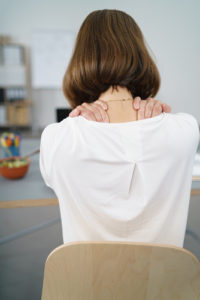What Is Spinal Stenosis?
Stenosis is the narrowing of any natural body orifice.
Spinal stenosis is a narrowing of the spinal canal area that houses the spinal cord and spinal nerves. It can occur in the cervical, thoracic or lumbar region of the spine.
Such narrowing may be caused by disc degeneration, disc herniation, facet syndrome, spinal cyst or thickening of the ligamentum flavum. Either way, Synergy Wellness Chiropractic & Physical Therapy located in New York City is equipped to diagnose and treat effectively with Cox Flexion Distraction and Deep Tissue Laser for Spinal Stenosis.
Causes of Spinal Stenosis
Spinal stenosis may be related to any number of causes, alone or in combination with other issues.
- Disc degeneration which starts in the second decade of life is a cellular level response to the stresses to the spinal structure due to aging and other environmental factors like mechanical stress from a disc herniation
- Facet syndrome in which disc thinning results in facet overlapping irritation
- Spinal cysts which invade the spinal canal and press on nerves.
- Ligamentum flavum bulging (thickening) not the disc that is 50% of the cause of spinal stenosis.
Effects of Spinal Stenosis
Spinal stenosis shows itself in a variety of ways. Balance is affected.
- Lumber spinal stenosis (LSS) patients have a higher risk of falling as a result of the onset of intermittent neurogenic claudication
- Muscle strength during the straight leg raising test and walking capacity are related in patients with Lumbar spinal stenosis.
- 10 to 14% of stenosis patients develop bladder and bowel symptoms.
- Pain may extend only to the thigh or buttock, Pain relief when sitting is common.
- Flexion opens the spinal canal and relieves pain (i.e., leaning over a shopping cart is relieving).
- Extension of the spine is painful.
- Exercise for the multifidus muscles is helpful as they degenerate, too.
- Nutrition is vital as inadequate concentrations of the disc nutrients result in cell death and disc degeneration. (9) Chondroitin sulfate is one nutrient shown to relieve pain and improve spinal function for 73% of patients in one study.
- Long-term use of chondroitin sulfate may be a disease-modifying agent for knee arthritis patients whose cartilage in the knee is similar to that in the disc.
- Chondroitin sulfate from Perna canaliculus has positive anti-inflammatory effects. It reduced inflammation (by 77%) better than NSAIDs (42%). It rebuilds bone, cartilage, tendons, ligament, and disc.
- Combining nutrition with spinal manipulation is beneficial as distraction reverses disc degeneration. One report showed that 28 days of compression caused degeneration, and 28 days of distraction regenerated the disc. Distraction rehydrates the disc, stimulates the matrix, increases the number of cells, and improves nutrition through the endplates through which the disc gets 70% of its nutrition.
- Combining nutrition and spinal manipulation is clinically beneficial care pathway to spinal stenosis relief.
Treatment Outcomes
Surgical vs. Non-Surgical
- Chiropractic Spinal manipulation is safe and recommended for acute low back pain by the US Depart of Health and Human Services.
- It is recommended by the American Pain Society and American College of Physicians as primary care of low back pain.
- Five to ten sessions of spinal manipulation over 2 to 4 weeks gives equivalent or superior improvement in pain and function compared with other options.
- For sciatica, treatment outcomes are equal with surgery or conservative care. Aggressive, non-surgical chiropractic care of spinal stenosis is reasonable and recommended.
- At 8 to 10 years post care, LSS patients improved about equally: 53% surgically vs. 50% non-surgically.
- Quality of life for surgically treated lumbar spinal stenosis patients is poor with satisfaction at 1-2 out of 10 for 71% of them.
- Chiropractic, non-surgical treatment offers an opportunity for relief with an understanding of the condition and ability to control the pain and patient’s quality of life.
Treatment Outcomes
Synergy Wellness Chiropractic & Physical Therapy uses a top of the line the new Cox 8 table. Just look at some of the results.
Cox Flexion Distraction Technic is gentle, safe, doctor-controlled spinal manipulation for spinal stenosis. Manipulation therapies such as flexion distraction (aka Cox Technic) are considered conservative treatment for lumbar spinal stenosis (LSS). The aim of care is the reduction of spinal stenosis by stretching the spinal ligaments known as the ligamentum flavum, reducing pressure within the intervertebral disc, and enlarging the nerve opening size. This aids in the healing of damaged nerves and function of related structures.
- Flexion-distraction (F/D) combines loads of traction and flexion to a specific spinal segment and increases the intervertebral foramen by as much as 28% in area and drops intradiscal pressures to as low as -192 mmHG.
- F/D manipulation results in increased motion of the metabolites in the discs and reduced internal pressure on the discs. Chronic back pain patients noted pain relief with F/D spinal manipulation with 4 weeks of care.
- It is reported to give 100% relief to a lady with low back pain and leg pain due to synovial cyst-induced spinal stenosis in 15 visits.
- Patients reported improvement for cervical radiculopathy and stenosis with a 41.4% in pain with Cox Technic.
- Cervical spinal stenosis with weakness and pain improved, dropping pain from a 7 to a 2 on a 10-point scale (10 being the worst pain).
- A patient with severe central canal stenosis affecting several levels of the spine found relief of pain with F/D.
- 12 treatments with F/D relieved pain for a 76-year-old man with MRI confirmed stenosis in 3 weeks.
- Lumbar spinal stenosis patients treated with F/D improved by 76%, and their disability improved by 73%.